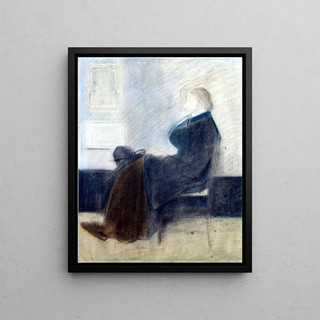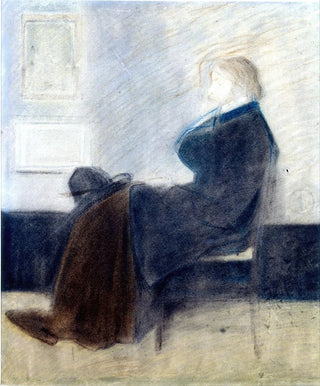Art print | Study of Thomas Carlyle - James Abbott McNeill Whistler


View from behind

Frame (optional)
Thomas Carlyle Art print by James Abbott McNeill Whistler – Captivating introduction
The "Thomas Carlyle" art print by James Abbott McNeill Whistler stands as a true masterpiece of the 19th century, revealing the finesse and depth of the relationship between art and subject. This painting, depicting the renowned writer and critic Thomas Carlyle, is much more than a simple portrait; it embodies an exploration of the psychological and emotional nuances that animate his model. Whistler, with his mastery of brushwork and keen sense of composition, manages to capture the very essence of Carlyle, while skillfully playing with light and shadow. The art print of this fascinating work invites the viewer to immerse themselves in a world where art transcends time and space, offering a rich and immersive visual experience.
Style and uniqueness of the work
Whistler's style in "Thomas Carlyle" is distinguished by a delicate and refined approach, typical of the Aesthetic movement of which he was one of the leading representatives. The artist uses subtle tones and a palette of soft colors that evoke an atmosphere of contemplation and serenity. The composition is carefully arranged, highlighting Carlyle’s thoughtful face, whose expression seems both introspective and engaged. Whistler's pictorial technique, blending fluid brushstrokes with meticulously detailed elements, creates a visual harmony that draws the eye and invites reflection. This work also stands out for its innovative use of space, where the background, though discreet, plays a crucial role in emphasizing the presence of the subject. Thus, "Thomas Carlyle" does not merely depict an individual; it evokes an atmosphere, a period, and a thought that still resonate today.
The artist and his influence
James Abbott McNeill Whistler, an emblematic figure of modern art, redefined the conventions of his time. Born in 1834, this American artist spent much of his life in Europe, where he was heavily influenced by the Impressionist movement and the artistic trends of his era. Whistler was a fervent advocate of the idea that art should be considered for its beauty and its

Matte finish

View from behind

Frame (optional)
Thomas Carlyle Art print by James Abbott McNeill Whistler – Captivating introduction
The "Thomas Carlyle" art print by James Abbott McNeill Whistler stands as a true masterpiece of the 19th century, revealing the finesse and depth of the relationship between art and subject. This painting, depicting the renowned writer and critic Thomas Carlyle, is much more than a simple portrait; it embodies an exploration of the psychological and emotional nuances that animate his model. Whistler, with his mastery of brushwork and keen sense of composition, manages to capture the very essence of Carlyle, while skillfully playing with light and shadow. The art print of this fascinating work invites the viewer to immerse themselves in a world where art transcends time and space, offering a rich and immersive visual experience.
Style and uniqueness of the work
Whistler's style in "Thomas Carlyle" is distinguished by a delicate and refined approach, typical of the Aesthetic movement of which he was one of the leading representatives. The artist uses subtle tones and a palette of soft colors that evoke an atmosphere of contemplation and serenity. The composition is carefully arranged, highlighting Carlyle’s thoughtful face, whose expression seems both introspective and engaged. Whistler's pictorial technique, blending fluid brushstrokes with meticulously detailed elements, creates a visual harmony that draws the eye and invites reflection. This work also stands out for its innovative use of space, where the background, though discreet, plays a crucial role in emphasizing the presence of the subject. Thus, "Thomas Carlyle" does not merely depict an individual; it evokes an atmosphere, a period, and a thought that still resonate today.
The artist and his influence
James Abbott McNeill Whistler, an emblematic figure of modern art, redefined the conventions of his time. Born in 1834, this American artist spent much of his life in Europe, where he was heavily influenced by the Impressionist movement and the artistic trends of his era. Whistler was a fervent advocate of the idea that art should be considered for its beauty and its






